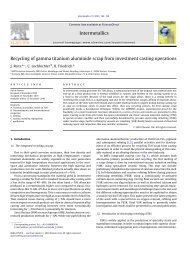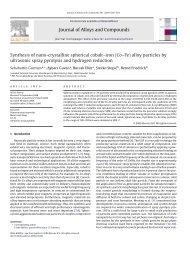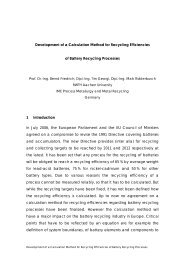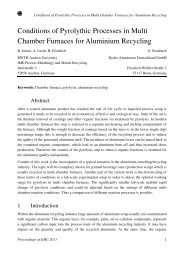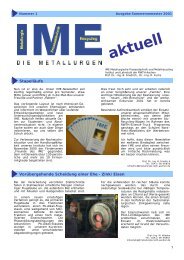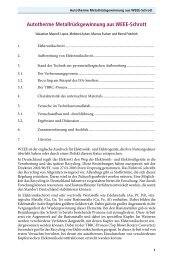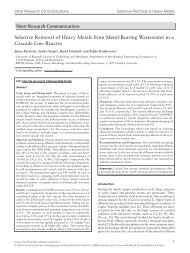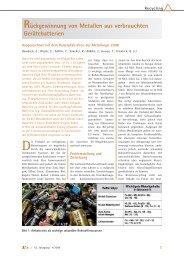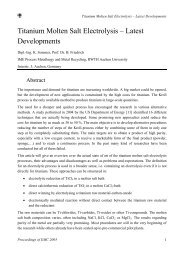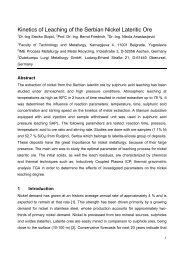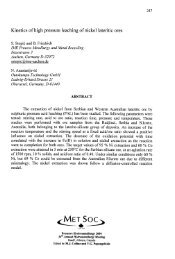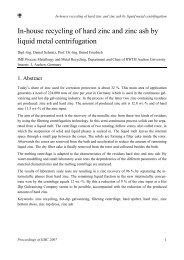Atmospheric leaching of EAF dust with diluted sulphuric acid
Atmospheric leaching of EAF dust with diluted sulphuric acid
Atmospheric leaching of EAF dust with diluted sulphuric acid
- No tags were found...
Create successful ePaper yourself
Turn your PDF publications into a flip-book with our unique Google optimized e-Paper software.
T. Havlik et al. / Hydrometallurgy 77 (2005) 41–50 49aMetal extraction [%]80604020Zn extraction; a/d = 1.2Fe extraction; a/d = 1.2bMetal extraction [%]80604020Zn extraction; a/d = 0.4Fe extraction; a/d = 0.4020 40 60 80Temperature [ • C]020 40 60 80Temperature [ • C]Fig. 10. (a) Dependency <strong>of</strong> metal extraction vs. <strong>leaching</strong> temperature at a/d=1.2. (b) Dependency <strong>of</strong> metal extraction vs. <strong>leaching</strong> temperature ata/d=0.4.temperature/pressure <strong>leaching</strong>). This is the reason thatonly a small amount <strong>of</strong> calcium remains in the solution.Fig. 10a to b show the dependencies <strong>of</strong> metalextraction on the <strong>leaching</strong> temperature for the highestand lowest <strong>dust</strong> charge, each in relation to theamount <strong>of</strong> <strong>acid</strong> available for the <strong>leaching</strong>. For thelowest charge amount <strong>of</strong> a/d=1.2, the zinc extractionis higher having the tendency to increase at a highertemperature. Yet, when using the lowest chargeamount, also the quantity <strong>of</strong> the dissolved iron ishigher compared to a/d=0.4. The comparison <strong>with</strong>the experiment at 100 8C, presented in work (Havliket al., 2004), reveals that this, under normal temperature/pressureconditions, is the optimum temperaturefor the maximal zinc extraction. However, theamount <strong>of</strong> extracted iron is several times higher at100 8C than at 80 8C. It seems that higher values <strong>of</strong>selectivity are obtained by lower temperature and,perhaps, a/d ratios.4. ConclusionAccording to the results obtained in this work, thehydrometallurgical recovery <strong>of</strong> zinc from <strong>EAF</strong> <strong>dust</strong> isfeasible <strong>with</strong> a relatively high recovery yield, whileiron mostly stays in solid phase. A similar conclusioncan be drawn in the case <strong>of</strong> high temperature/pressure<strong>leaching</strong> under equivalent experimental conditions.Comparing the results <strong>of</strong> this work <strong>with</strong> thoseobtained by high temperature/pressure <strong>leaching</strong> manifestthat, concerning the zinc extraction, the last ismore effective. Yet, this does not relate to iron.Additionally, calcium permanently remains in thesolution. Although in high temperature/pressure<strong>leaching</strong> calcium is dissolved first, it later precipitatesas calcium sulphate. This does only relate to temperaturesup to 150 8C and pressures up to 4.1 bar. Evenin higher temperatures/pressures <strong>leaching</strong> calciumpermanently remains in the solution. This behaviourresults from using a low concentration <strong>of</strong> <strong>sulphuric</strong><strong>acid</strong>. This also causes in fact a decrease in the zincyield, yet the amount <strong>of</strong> dissolved iron is low. In sucha way, it can be possible to set up the conditions for anoptimum zinc yield into the solution <strong>with</strong> a minimisediron dissolution. However, the problem persists thatthe chemical and mineralogical composition <strong>of</strong> eachsteelmaking <strong>dust</strong> is individual and that for each onethe conditions <strong>of</strong> processing have to be studied.AcknowledgementThe authors wish to express their gratitude toSlovak grant agency VEGA (Grant 1/9379/02) forfinancial support.ReferencesBarrett, E.C., Nenniger, E.H., Dziewinski, J., 1992. A hydrometallurgicalprocess to treat carbon steel electric arc furnace<strong>dust</strong>. Hydrometallurgy (30), 59–68.



